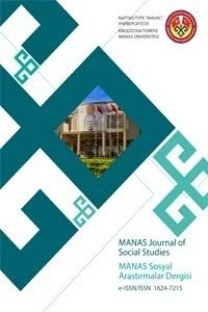OCCUPATIONAL BURNOUT AT THE AMERICAN UNIVERSITY OF CENTRAL ASIA IN KYRGYZSTAN
___
Ahola, K., Honkonen, T., Virtanen, M., Aromaa, A., Lὅnnqvist, J. (2008). Burnout in relation to age in the adult working population. J Occup Health, p.3.Arden, J. (2002). Surviving Job Stress: How to Overcome Workday Pressures, pp.105-106.
AUCA at a glance. Bishkek. Available from: < https://auca.kg/en/auca_at_a_glance/>
Barutçu, E., Serinkan, C. (2008). Burnout syndrome: an important problem today, and a research study conducted in Denizli. Ege akademik bakış, pp. 541-561.
Barutçu, E., Serinkan, C. (2013). Burnout syndrome of teachers: An empirical study in Denizli in Turkey. 2nd Cyprus International Conference on Educational Research.
Baum, A. (1997). Cambridge Handbook of Psychology, Health and Medicine. Cambridge University Press, p. 275.
Cahir, J. (2011). Burnout in university teaching staff. Available from http://www.mq.edu.au/lih/blog/?p=2249
Freudenberger, H. (1974). Staff burnout. Journal of Social Issues, pp. 159–165.
Fynchina, F. (2012). Academic Burnout, Academic Procrastination and GPA in junior and senior students of the American University of Central Asia. American University of Central Asia. Psychology Department, p. 5.
Gryna, Frank, M. (2003). Work Overload!: Redesigning Jobs to Minimize Stress and Burnout, p.3.
Ladstätter, F., Garrosa, E. (2008). Prediction of Burnout: An Artificial Neural Network Approach, pp. 1-4.
Lambert, R. G., McCarthy, C. J. (2006). Understanding Teacher Stress in an Age of Accountability, pp.147, 187.
Leiter, M., Maslach, C. (2016). Latent burnout profiles: A new approach to understanding the burnout experience. https://doi.org/10.1016/j.burn.2016.09.001, p. 2.
Lundgren-Nilsson, A., Jonsdottir, I., Pallant, J., Ahlborg, G. (2012). Internal construct validity of the ShiromMelamed Burnout Questionnaire. doi: 10.1186/1471-2458-12-1, p.1.
Mäkikangasa, A., Kinnunenb, U. (2016). The person-oriented approach to burnout: A systematic review.
Maslach, C. (1982). Burnout: The cost of caring. Englewood Cliffs, NJ: Prentice Hall, p. 2-10.
Maslach, C., Jackson, S. (1981). The measurement of experienced burnout. Journal ofoccupational behavior. Vol. 2.99-113.
Maslach, C., Jackson, S., Leiter, M. (1997). The Maslach Burnout Inventory Manual.
Maslach, C., Leiter, M., Schaufeli, W. (2008). Measuring burnout, p.13.
Pisanti, Doef, Maes, Lazzari, Bertini. (2011). International Journal of Nursing Studies. Volume 48, Issue 7, p. 829-837. P otter, B. (1995). Preventing Job Burnout: Transforming Work Pressures into Productivity. Paris, J.Franks, Phil, p.1.
Potter, Beverly, A. (1995). Preventing job burnout: Transforming job pressures into productivity, p.1.
Reis, D., Xanthopoulou,D., Tsaousis, I. (2014). Measuring job and academic burnout with the Oldenburg Burnout Inventory (OLBI): Factorial invariance across samples and countries. Burnout Research 2 (2015) 8–18, Elsevier, p. 2.
Richter, A., Kostova, P., Harth, V., Wegner, R. (2014). Children, care, career – a cross-sectional study on the risk of burnout among German hospital physicians at different career stages. J Occup Med Toxicol. Published online 2014 Dec 3. doi: 10.1186/s12995-014-0041-6, p. 1-5.
Survey Results Using the Maslach Burnout Inventory. Available from
Work-related 'burnout' more likely to affect the best lecturers, study suggests. (2011). Available from
- ISSN: 1694-7215
- Yayın Aralığı: Yılda 4 Sayı
- Başlangıç: 2001
- Yayıncı: KIRGIZİSTAN-TÜRKİYE MANAS ÜNİVERSİTESİ
VEDAT AKTEPE, ABDULKADİR UZUNÖZ, MEVLÜT GÜNDÜZ
ÖRGÜTSEL ADALET ALGISI’NIN ÇALIŞANLARIN İŞ DOYUMU VE İŞTEN AYRILMA EĞİLİMİNE ETKİSİ
DİNİ KAHRAMANLIK DESTANLARI ÜZERİNE
Aybeniz RAHİMOVA, HALİDE GAMZE İNCE YAKAR
YEREL SİYASETTE TEMSİL VE KATILIM: KADIN AKTÖRLER
ALGILANAN SOSYAL KAYTARMANIN ÖRGÜTLERDE ÇATIŞMA EĞİLİMİNE ETKİSİ
ALGILANAN ÖRGÜTSEL ADALET VE İŞTE VAR OLAMAMA (PRESENTEEISM) İLİŞKİSİNDE STRESİN ARACI ROLÜ
A. Asuman AKDOĞAN, Yasemin KAYA HARMANCI, ALİ BAYRAM
Galip Afşin RAVANOĞLU, AZİZ BOSTAN, ALPER YILMAZ
AHMET MİTHAT’IN NİZÂ-I İLM Ü DİN ADLI ESERİNDE DİN VE BİLİM ÇATIŞMASI SORUNU
KONTROL ODAĞI VE GİRİŞİMCİLİK EĞİLİMİ İLİŞKİSİ: KTMÜ ÖĞRENCİLERİ ÜZERİNE BİR ARAŞTIRMA
HASAN GÜL, Aysuluu BEYŞENOVA BEYŞENOVA
SANAT EĞİTİMİ ALAN ÖĞRENCİLERİN İMGE ÇÖZÜMLEME VE UYGULAMADA GÖRSEL KÜLTÜR ALGILARININ BELİRLENMESİ
